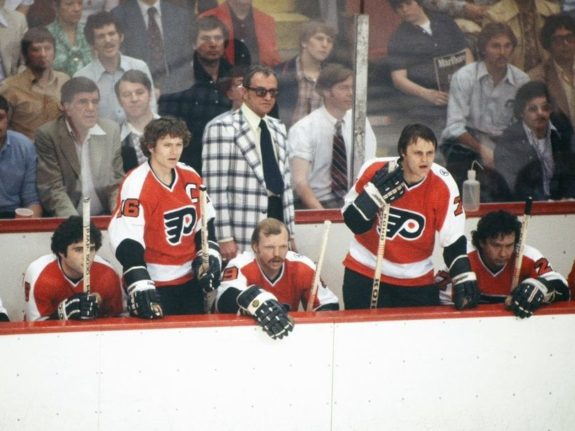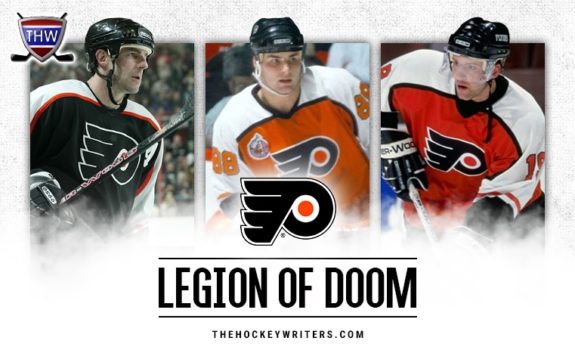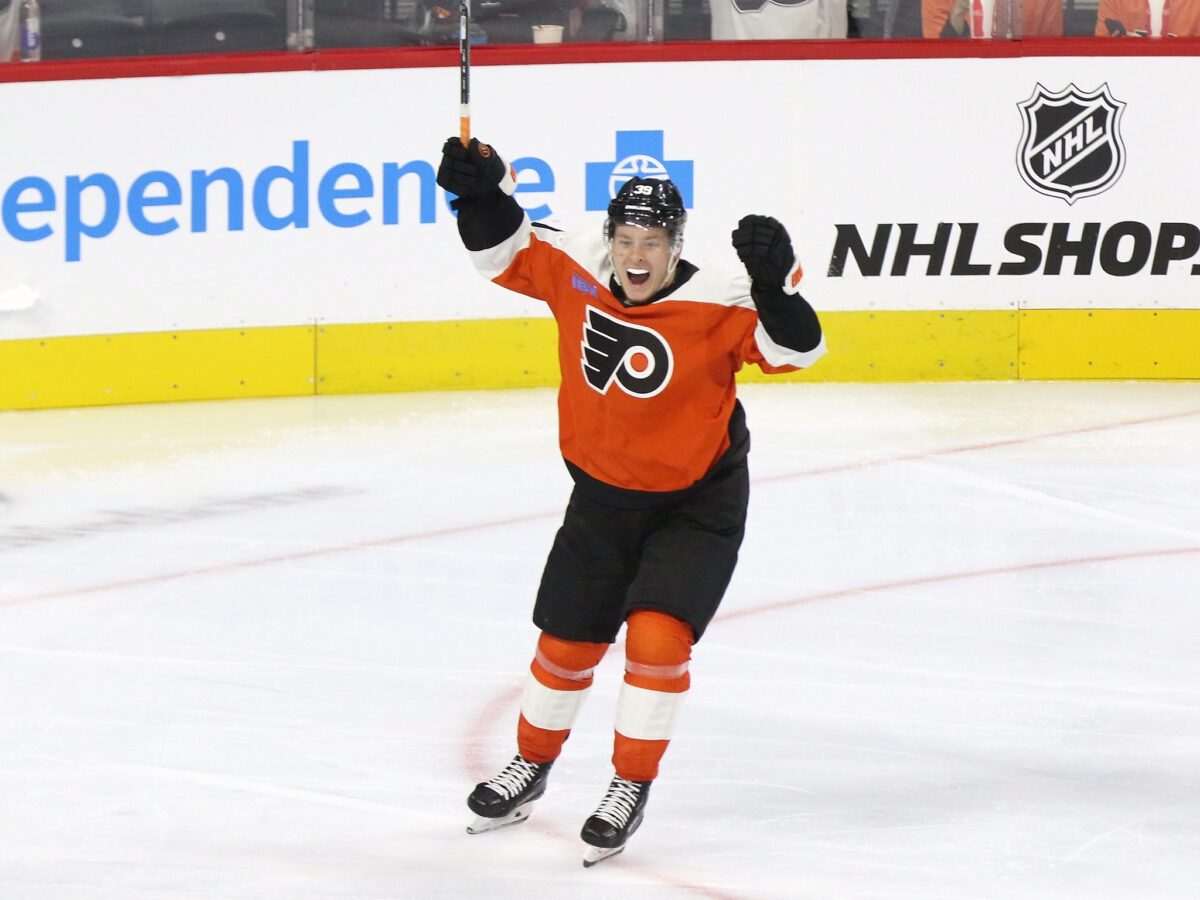The Philadelphia Flyers of the present have avoided one core trait that used to define their organization. The current regime, manned by many players of old, thinks the identity of the franchise is toughness and physicality like the Broad Street Bullies of the mid-1970s. But that’s not why the Flyers had eight Stanley Cup Final appearances between 1974 and 2010. The real reason, you ask? Never being complacent.
The world lost a caring man when Ed Snider passed away in 2016. Today, his legacy lives on through his youth hockey program, intending to make the sport he loved more accessible to younger generations. Focusing on how he impacted the NHL, his commitment to winning was pretty rare for an owner. When the founder of the Orange and Black was still working with the team, they were consistently making headlines. Big trades and free-agent signings were routine. If the Flyers wanted a player, they got that player—it was simple.
This gets to the point of the Flyers reportedly being in the mix for disgruntled 21-year-old defenseman David Jiricek, but not being a front-runner by any means. When Snider was at the helm, it wasn’t just discontent players that his team was after. If there was a hole in the Flyers’ roster, it would be addressed no matter what. But that identity is gone. The last 13 seasons in Philadelphia are evidence of its importance.
Flyers Were Once the Blueprint for Success
For decades, the Flyers were one of the most inevitable teams in sports. During the first 44 seasons of their history, they made the playoffs 36 times, missing the playoffs as often as they reached the Stanley Cup Final (eight times apiece). Approximately once every five seasons, they sported the Stanley Cup crest on their sweaters. The Orange and Black were the blueprint for success.
The Flyers were consistently dominant for a few reasons. For one, their drafting was sensational. Outside of the first round, they landed cornerstones such as Bobby Clarke, Tim Kerr, and Rick Tocchet. They weren’t perfect in the first round, but Bill Barber and Brian Propp each gave over 10 seasons of their time to Philadelphia, keeping the team successful from 1972-73 up until 1989-90 when both of them were gone.

On top of drafting, the Flyers were as bold as ever in the trading department. Five days after winning their first Stanley Cup in 1974, they made a splash for California Golden Seals winger Reggie Leach. He was an important contributor to their second straight championship in 1975 but came into his own next to Barber and Clarke in the 1975-76 season, forming the potent LCB line. He buried 61 goals and set a playoff record with 19 of them en route to yet another appearance in the Final. The Flyers were bested by the Montreal Canadiens, but their proactivity gave them that extra push.
In the 1982 offseason, Philadelphia made their next franchise-altering splash. They acquired defenseman Mark Howe from the Hartford Whalers for a plentiful sum, but the cost was worth it. He was a Flyer for 10 seasons, finishing as a Norris Trophy finalist three times. Getting a player who was one of the best at his position for around a decade seems like a no-brainer, but the Whalers agreed to the move. The Flyers took a risk and it paid off to the tune of two Stanley Cup Final appearances.
Once the 1980s ended, Philadelphia entered an extended stretch of non-playoff hockey for the first time ever. After having their first pair of consecutive postseason misses in team history (1989-90 and 1990-91), the Orange and Black sensed change was needed. First, they acquired young forward Rod Brind’Amour from the St. Louis Blues. He gave the Flyers nine worthwhile seasons, later becoming a vital piece to the team’s playoff success.
Shortly after, Tocchet was traded to the Pittsburgh Penguins. This led to the Flyers’ in-state rival winning a championship, but Philadelphia didn’t lose the trade. Mark Recchi was the notable return in the deal, and he holds the single-season franchise points record of 123. He didn’t have a profound impact during this stretch due to the roster around him, but his importance was felt for another decade. We’ll get to why in a bit.
Months later, the Flyers won the bid for generational prospect Eric Lindros. Desiring a new direction, they traded for who they hoped could be the face of the NHL one day. He showed early signs of this, putting up 172 points in 126 games over his first two seasons. But it was a big, risky trade in 1995 that allowed him to reach his peak—let’s get back to Recchi.
Despite him being a star player and seemingly an integral part of the Lindros movement in Philadelphia, Recchi was traded to the Canadiens early in the shortened 1995 season. Most notably, the Flyers received winger John LeClair and defenseman Eric Desjardins. Trading who was objectively the best player in this deal helped end a five-year playoff drought and brought the best out of Lindros and the core around him for another decade.
Lindros and LeClair combined for the scariest duo in the NHL, with Mikael Renberg tagging along to form the Legion of Doom line. Lindros tied with Jaromir Jagr for the league lead in points for 1994-95, bringing home the Hart Trophy. Desjardins was essentially a Howe replacement, quickly becoming a regular Norris Trophy candidate. After losing 14 more games than they won the season prior, the Orange and Black made it all the way to the 1995 Eastern Conference Final led by their shiny trio and new defender.

The Lindros era was unfortunately short-lived, with him being traded in 2001. Still, he and LeClair made the Eastern Conference Final three times and the Stanley Cup Final once while teammates—to say they weren’t successful would be untrue. Even after Lindros was gone, the Flyers managed to stay afloat. Trade and free-agent additions like Keith Primeau, Jeremy Roenick, Recchi (again), Tony Amonte, and Michal Handzus helped them remain atop the standings and even advance to Game 7 of the 2004 Eastern Conference Final. Always aggressive, the Orange and Black were quite fine without their Hall of Fame centerman.
The Flyers’ age started to catch up with them in 2006-07, though. Not only did they miss the playoffs for the first time since 1993-94, but they had the worst record in the NHL. In classic Snider-era fashion, the Flyers went all out to right their wrongs in the 2007 offseason. For a single late first-round pick, they acquired Kimmo Timonen and Scott Hartnell, who were both key figures in their 2010 Stanley Cup Final roster. The same was the case with Daniel Briere, who was scooped up in free agency. Choosing to build around young forwards Mike Richards and Jeff Carter didn’t result in a championship, but the Flyers went from the basement to the 2008 Eastern Conference Final and reached further heights shortly after—their turnaround was special.
The Flyers roster couldn’t have had their 2010 success without the splash to add legendary defenseman Chris Pronger. If you thought a salary cap would stop the team from getting better, think again—they spent their money wisely and were never content. If something didn’t feel right, a change was made. That’s just how the Flyers were back then. One day (around the 2013 lockout), that philosophy ceased to exist. At that moment, Philadelphia being a blueprint for success did, too.
What Happened to the Flyers?
The last game-breaking move the Flyers made—or, tried to make—was their 2013 offer sheet to defenseman Shea Weber. Their 14-year offer that the Nashville Predators matched still has the 39-year-old under contract despite not having a game under his belt since the 2021 Stanley Cup Final. Aside from that maneuver that would have likely kept the team competitive for a bit longer, there was no backup plan.
This is where we get into the dark ages of the Flyers. As mentioned, they only missed the playoffs eight times during their first 44 seasons. Since the lockout-shortened 2013, they have also missed the playoffs eight times and are on pace to do it a ninth in 2024-25. This isn’t a coincidence, and the salary cap cannot be blamed—the Flyers just don’t operate like they used to. The same organization went from the league’s worst team to one of the last four alive in the playoffs with just one offseason of moves during the salary cap era (since 2005-06).
The old Flyers weren’t afraid to trade their stars. Players like Tocchet and Recchi weren’t off the table, yet both of those trades made the team better. Sure, they had their swings and misses, like the majority of the 2011 offseason. But instead of going for the home-run ball and missing it occasionally, the Flyers have struck out looking for over a decade now. Going out and making moves has simply not happened.
In the 2024 offseason alone, we can point to how things changed. The Carolina Hurricanes’ Martin Necas, a player of need, was on the trade block—nobody made a significant push, so he signed a bridge deal in Carolina. It’s hard to say if his production is legitimate, but he has become one of the league’s new superstars numbers-wise (first in NHL scoring through American Thanksgiving). This is the type of player the old Flyers would have traded for to end their current four-year playoff drought. Now, he’s completely unattainable. They missed their shot.
Related: Flyers Should Be All-in on Martin Necas
Rather than weaponizing their players, draft picks, and prospects, the Flyers have sat tight. From their 2022-23 team, no major assets aside from Ivan Provorov (and maybe Kevin Hayes) have been traded. The core of Travis Konecny, Owen Tippett, Joel Farabee, Sean Couturier, Morgan Frost, Tyson Foerster, Scott Laughton, Travis Sanheim, Cam York, and Rasmus Ristolainen remains. Whether or not it’s justified, the Flyers have grown complacent.
Potentially tying the franchise record for consecutive playoff misses means nothing. Breaking their Stanley Cup Final appearance drought record (previously 11 seasons; 1998-2010) means nothing. A hunger to win has turned into apathy.
How Today’s Flyers Can Change
Hope shouldn’t be lost for the Flyers of today, though. It’s a step in the right direction if they can land Jiricek, even if they don’t “win” the trade. However, they need more than just one player. In order to provide budding superstar Matvei Michkov with a roster to contend, the Flyers might have to go out and make it happen. This means being unorthodox, much like the team was under Snider’s reign.
If there is a player the Flyers want, they should try their hardest to make it happen. Robert Thomas from the St. Louis Blues is in his mid-20s on a below .500 hockey team with major players not getting any younger. Perhaps they want to fully embrace the youth movement and get a haul for their star center. It won’t be cheap, especially since he’s not actively on the trade block, but the gamble is worth it to make Michkov better. This is just an example, but it’s the type of move the Flyers should be looking for.

When there’s a player that emerges in trade rumors, fans want the Flyers to jump on it. But why should they be limited to players in the headlines? Wouldn’t it be more beneficial to push for the best player they can buy, even if that cost is higher? At least for Snider’s teams, the answer to that last question was yes.
You can disagree with how they got there and argue they need to evolve with the times, but the Flyers were once a great hockey franchise. Their defining characteristic was their drive, never settling for anything but the best. Unfortunately, they have lost that drive in recent years. Can they gain it back? Should they gain it back?
